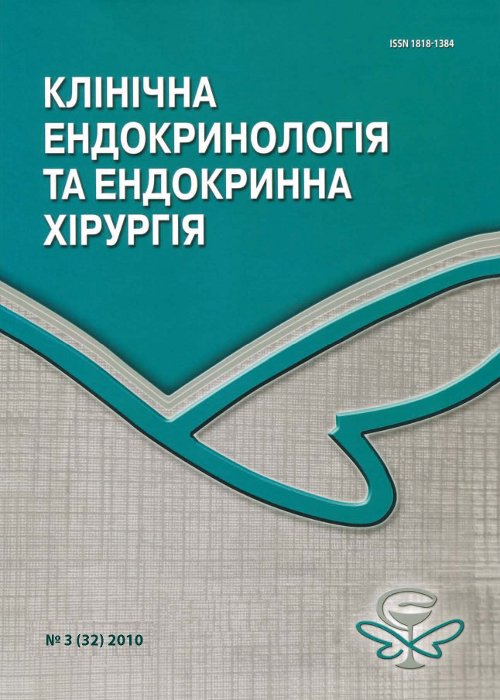Стан ендокринної функції тимуса у дітей групи ризику у передклінічний період розвитку цукрового діабету 1-го типу
DOI:
https://doi.org/10.24026/1818-1384.3(32).2010.96446Ключові слова:
Type 1 diabetes mellitus, thymulin, autoantibodies, childrenАнотація
The authors present the results of a study of blood levels of thymulin (a hormone that is secreted by thymic epithelial cells) in 69 normoglycemic children being at increased risk of type 1 diabetes mellitus development (offsprings of first line kin and sibs of diabetes mellitus patients), and in 18 children with newly diagnosed diabetes before insulin therapy initiation. The control group consisted of 39 practically healthy children without a family history of diabetes mellitus. In 38 children from the risk group, antibodies to antigens of pancreatic beta cells (GAD, IA-2, IAA) were identified; in the rest of children from this group (31 children) autoantibodies (AAB) were not revealed in the blood. It has been established that in children from the risk group with a positive response to AAB, thymulin content was by 1.5 times (р<0.001) lower compared with control values. The most significant decrease in thymulin secretion was observed on the eve of diabetes manifestation. The data obtained suggest the presence of thymic functional abnormalities in children with autoimmune process in the pancreas. A decrease in thymulin blood levels was noted in the period preceding the development of clinical phase of the disease. Thymulin level assay in children with a family history of diabetes may be used as an additional criterion for assessment of the likelihood of type 1 diabetes mellitus development.Посилання
Gianani R., Eisenbarth G.S. The stages of type 1A diabetes: 2005 // Immunol. Rev. — 2005. — Vol. 204. — P. 232–249. https://doi.org/10.1111/j.0105-2896.2005.00248.x
Atkinson M.A. Thirty years of investigating the autoimmune basis for type 1 diabetes // Diabetes. — 2005. — Vol. 54. — P. 1253–1263. https://doi.org/10.2337/diabetes.54.5.1253
Geenen V., Brilot F., Louis C. et al. Importance of a thymus dysfunction in the pathophysiology of type 1 diabetes // Rev Med Liege. — 2005. — Vol. 60, No 5–6. — P. 291–296.
Gallegos A., Bevan M.J. Central tolerance: good but imperfect // Immunol. Rev. — 2006. — Vol. 209. — P. 290–296. https://doi.org/10.1111/j.0105-2896.2006.00348.x
Geenen V, Mottet M, Dardenne O. et al. Thymic self-antigens for the design of a negative/tolerogenic self-vaccination against type 1 diabetes // Сurr. Opin. Pharmacol. — 2010. — Vol. 10, No 4. — P. 461–472. https://doi.org/10.1016/j.coph.2010.04.005
Krenger W. Foreign and self — the challenge for the immune system // Schweiz. Rundsch. Med. Prax. — 2007. — Vol. 96, No 6. — P. 199–204. https://doi.org/10.1024/1661-8157.96.6.199
Kwon H., Jun H.S., Yang Y et al. Development of autoreactive diabetogenic T cells in the thymus of NOD mice // J. Autoimmun. — 2005. — Vol. 24, No 1. — P. 11–23. https://doi.org/10.1016/j.jaut.2004.10.002
Bach J.-F., Dardenne M. Thymulin, a zinc-dependent hormone // Med. Oncol. Tumor Pharmacother. — 1989. — Vol. 6, No 1. — P. 25–29.
Reggiani P.C., Morel G.R., Gloria M. Cónsole G.M. et al. The thymus-neuroendocrine axis: physiology, molecular biology, and therapeutic potential of the thymic peptide thymulin // Ann. N. Y. Acad. Sci. — 2009. — Vol. 1153. — P. 98–106. https://doi.org/10.1111/j.1749-6632.2008.03964.x
Savino W., Dardenne M. Neuroendocrine Control of Thymus Physiology // Endocrine Reviews. — 2000. — Vol. 21, No 4. — P. 412–443. https://doi.org/10.1210/edrv.21.4.0402
Fabris N., Mocchegiani E. Endocrine control of thymic serum factor production in young-adult and old mice // Cell. Immunology. — 1985. — Vol. 91, No 2. — P. 325–335. https://doi.org/10.1016/0008-8749(85)90230-8
Чеботарев В.Ф. Современные представления о механизмах аутоиммунного процесса. Аутоагрессия и проблема иммунореабилитации при эндокринной патологии // Імунологія та алергологія. — 1998. — No 1–2. — С. 59–63.
Chebotarev V., Zubkova G., Zamotayeva G. et al. Comparative study of thymic function and induced nonspecific immunity in children with complicated and insulin-dependent diabetes mellitus // Abstr. I World Congress Child Health–2000 (Canada). — 1995. — P.256.
Vocchegiani E., Paolucci P., Granchi D. et al. Plasma zinc level and thymic hormone activity in young cancer patients // Blood. — 1994. — Vol. 83. — P. 749–757.
Bach J.-F. Insulin-dependent diabetes mellitus as an autoimmune disease // Endocrine Rev. — 1994. — Vol. 15, No 4. — P. 516–542. https://doi.org/10.1210/edrv-15-4-516
##submission.downloads##
Опубліковано
Номер
Розділ
Ліцензія

Ця робота ліцензується відповідно до Creative Commons Attribution-NonCommercial 4.0 International License.





